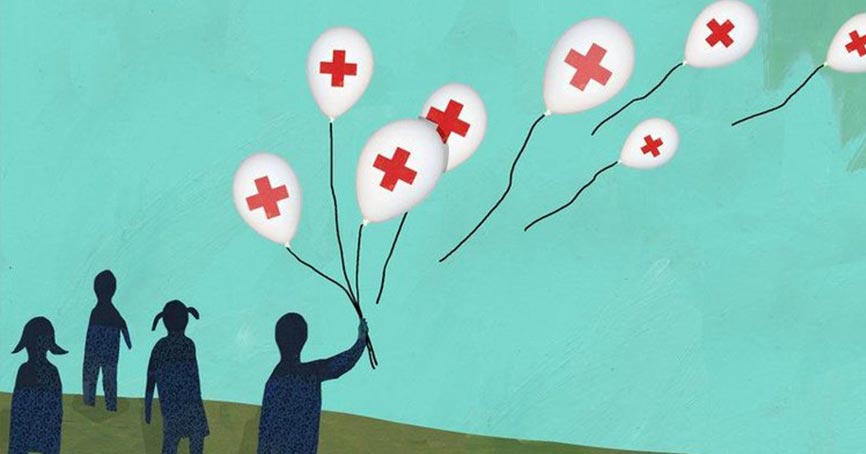Some diseases are more likely to occur in the summer season while others may find their way in other seasons. Summers bring in a host of health issues like diarrhea, kidney stones, jaundice, measles, skin rashes, sunburns, persistent headaches and types of fever. On the other hand, winters are known for cold, flu and cough and monsoon for dengue and malaria.
What is a fever?
Fever is a term that is used to describe a rise in body temperature. The
normal human body temperature should be anywhere between 36°C - 37°C (98 - 100 F), however, the temperature may vary depending on several factors like sleep pattern, the food we consume, physical activity and so on.
The body temperature increases above the normal range when the immune system of the body comes in contact with a foreign body. Fever confirms that the immune system is fighting to eliminate bacteria or virus from the body.
Please Note: A fever or high temperature is NOT an illness in itself. Usually, it is the symptom of a condition, most often due to an infection.
Based on how severe the case is, fever is graded into three types:
Low-Grade Fever- Body temperature lying between the range 100 F and 101 F, comes under the low-grade fever range.
High-Grade Fever- Body temperature lying between the range 103 F and 104 F, indicates one is suffering from high-grade fever.
Dangerous Range of Temperature- Body temperatures exceeding 104 F is a case of very high-grade fever. This poses serious health risks and requires clinical attention at the earliest.
What are the causes of fever?
The hypothalamus, that is a part of the brain, controls the body temperature as it usually varies throughout the day. With a normal temperature of 98.6 F, it keeps changes. However, as a response to illness, infection and other causes, the hypothalamus resets the body to a higher temperature.
Some of the most common causes of fevers are colds and gastroenteritis. However, there may be other causes as well as-
- Ear, lung, skin, throat, bladder or kidney infection
- Inflammation causing conditions
- Cancer
- Vaccines
- Side effects of drugs
Besides this, there may be also other intricate causes like-
- Blood Clots
- Hormone disorders like hyperthyroidism
- Illegal drugs like amphetamines and cocaine
- Hormone Diseases like inflammatory bowel disease, lupus, and rheumatoid arthritis
What are the Types of Fever in Summers?
Summer season is known to trigger a number of health issues from high-end fevers to issues like kidney stones, etc. Some of the types of fever that can be usual symptoms indicating something big are-
Fever during Chicken Pox
Chickenpox is one of the most common summer diseases and starts in the form of small fluid-filled red rashes. These rashes come along with fever that may go up to 102 Fahrenheit. It ultimately turns into blisters which crust over the skin and may leave marks. People with a weak immune system are prone to chicken pox.
Some of the common symptoms of chickenpox include blisters, itchy skin, scabs, redness, loss of appetite and headache lasting for more than a week.
Typhoid Fever
Typhoid fever is a disease that passes on through the oral-fecal route to healthy individuals. Also known as typhoid fever, this water-borne disease spreads through contaminated food and water which is the breeding ground for bacteria.
Some visible symptoms include weakness, high fever, loss of appetite, fatigue, pain in the abdomen, etc. To prevent a person from contracting the disease, vaccination is advisable beforehand.
High Fever and Measles
The main reason behind this type of fever is a highly infectious virus or a person who has a weak immune system. A viral disease that spreads rapidly, it is an endemic disease.
Endemic diseases are continually present in the community and over time as one contracts it, one develops resistance too.
Some of the common visible symptoms of measles are high fever, cough, conjunctivitis, runny nose, watery eyes, sneezing and red rashes over the body.
Fever and Mumps
Out of all the summer diseases, mumps is an extremely contagious viral disease and just like other summer diseases, it occurs during peak summers. Contagious in nature, it transmits from an infected person who coughs or sneezes to another.
Some symptoms of mumps include fever, loss of appetite, weakness, headache, swelling in the salivary gland, muscle ache, etc.
Prevention of Fever and Related Diseases in Summer
Summer is a favorable season which is linked to the outbreak of a number of diseases. This happens because of suitable weather conditions for virus, bacteria and other parasites to bread. Here are a few suggestions that one can follow to remain immune from the much-dreaded summer season fever.
- Avoid activities outside the home during peak sun hours.
- Avoid Exposure to direct sunlight and crowded areas.
- Increase liquid intake to prevent dehydration.
- Avoid roadside food or contaminated water.
- Use sunscreen with higher SPF as it prevents skin damage.
- Consume more fruits and vegetables.
- Prefer light-colored clothing as they absorb heat.
- Stay in a clean and healthy environment.
Summer is a beautiful time to enjoy vacations and spend time with family, friends, making memories only if you are healthy. All that you need to do to stay fit is the little awareness and few precautions to enjoy the good times.
Bibliography
- https://www.pediatricsafety.net/2012/06/6-summer-illnesses-you-need-to-know-how-to-spot-treat-them/
- http://stylesatlife.com/articles/types-of-fever/
- http://www.thehealthsite.com/fever/
- https://www.medicalnewstoday.com/articles/37135.php

 Jun 04, 2019
Jun 04, 2019
 May 30, 2018
May 30, 2018 May 10, 2018
May 10, 2018 May 17, 2018
May 17, 2018